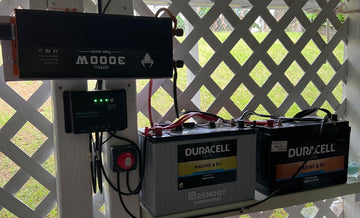The solar charge controller is an important component in a solar power installation. As a clean, renewable energy source, solar energy is becoming an increasingly popular energy choice. To ensure optimal performance and longevity of a solar power system, it is necessary to install a solar charge controller. In this article, we will explore the types of solar charge controllers, how they work, and why they are important in solar power installations.
What is a solar Charge Controller?
Solar panels convert solar energy into electricity to be stored in batteries, however, continuing to supply power to the batteries after they are fully charged can lead to battery damage. The solar charge controller becomes critical, sitting in the middle of the solar cells and battery bank, to control the current and voltage inputs from the solar panel to the battery or electrical loads (refrigerators, fans, lights, surveillance cameras). The controller safely charges and keeps the battery at a high state of charge without overcharging, keeping the battery safe for use and extending its life. However poor quality charge controllers can cause the battery to fail and cause the entire off-grid system to shut down.

Types of Solar Charge Controllers
There are primarily two types of solar charge controllers: Pulse Width Modulation (PWM) and Maximum Power Point Tracking (MPPT). These types differ in their charging methods and efficiency in harnessing solar power.
PWM Charge Controllers
They effectively regulate the voltage reaching the battery by rapidly switching the current to the solar panel and are usually more common in small solar power systems. The PWM controller maintains a fixed voltage (usually the optimal charging voltage for the battery) output during the charging process. When the battery voltage is close to full load, it will reduce the charging current and gradually reduce the charging speed.
PWM controllers are typically less expensive than MPPT controllers. They are suitable for systems where the solar panel voltage is relatively close to the battery voltage.
MPPT Charge Controllers
MPPT controllers tend to be more expensive than PWM controllers, but are of the highest quality, delivering 10-30% more power to the solar cell than other types. It is usually a worthwhile investment for any solar electric system over 200 watts.MPPT controllers utilize more advanced electronics to track and optimize the maximum power point (MPP) of the solar panel. Solar panels have an optimal voltage at which they produce maximum power output. The MPPT controller adjusts its output voltage to match the solar panel's maximum power point, ensuring maximum power transfer.
The MPPT controller can handle solar panels with higher voltages and convert the excess voltage into additional charging current, thereby increasing efficiency and reducing charging time. The MPPT controller is especially advantageous in systems where the solar panel voltage is much higher than the battery voltage, or when the solar panels are shaded or sunlight conditions change.
How does a solar charge controller work?
In solar systems, voltage differences between solar panels and batteries are common, and current flows from high voltage to low voltage. During the day, the solar panel has a higher voltage than the battery, and current flows from the solar panel to the battery. At night, the voltage of the battery is higher than the solar panel. The solar controller is electronically protected against nighttime reverse current, short circuits, high voltage, high temperature, and battery reverse polarity. It controls the flow of current from the battery to the load, providing stable power.
In addition, some controllers have a low-voltage disconnect feature that allows the charge controller to automatically disconnect non-critical loads from the battery bank when the voltage drops below a certain threshold.
Supplies power to (DC) loads
A diagram of how the solar charge controller is connected to power a direct current (DC) load is shown below:

When installing a solar charge controller, it is recommended that you connect and disconnect in the following order:
- Insert batteries into the controller first
- PV array to the controller
- Electrical loads to the controller
To disconnect, reverse this sequence. The battery powers the controller, so always make sure the solar and load are disconnected before connecting or disconnecting the battery from the controller. Connections between the battery, load, PV array, and controller should have a disconnect switch for added safety and ease of installation and removal.
In the DC load wiring diagram above, sunlight strikes the solar module, which converts the solar energy to DC power and transmits it to the charge controller. The charge controller regulates the current and voltage transmitted to the load. When the solar module provides more power than the load requires, the excess power is transferred to the battery system. In this way, the batteries are kept charged without being overcharged!
Work with AC load
The following diagram depicts the components and connections to power an AC load. This AC load diagram differs from the previous DC load example in that we have added an inverter to the system. The purpose of the inverter is to convert the DC power from the batteries to AC power that can be used to run the AC loads

The inverter is connected and powered through the battery, not through the load terminals of the controller as we did in the DC load example. This is because the inverter may generate a high energy surge at startup and this high current surge may be higher than the rated capacity of the charge controller, whereas the battery will be able to meet the high energy surge requirements.













